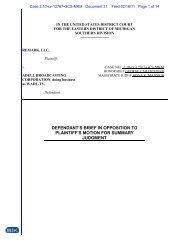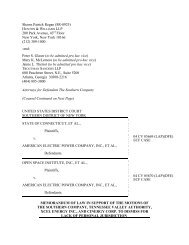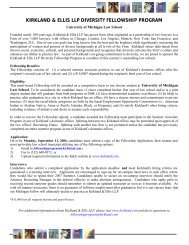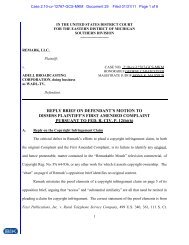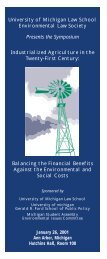Conn. v. American Electric, Memo in Support of Motion to Dismiss ...
Conn. v. American Electric, Memo in Support of Motion to Dismiss ...
Conn. v. American Electric, Memo in Support of Motion to Dismiss ...
You also want an ePaper? Increase the reach of your titles
YUMPU automatically turns print PDFs into web optimized ePapers that Google loves.
protect<strong>in</strong>g environmental quality” and the decision process “<strong>in</strong>tegrated economic development<br />
and environmental goals.” Id. at 7,573-7,574. As summarized <strong>in</strong> the Record <strong>of</strong> Decision:<br />
Id. at 7,573.<br />
The primary analytical method used for Energy Vision 2020 was the<br />
multi-attribute trade<strong>of</strong>f method. This approach allowed TVA <strong>to</strong><br />
quantitatively <strong>in</strong>tegrate the identified environmental impacts <strong>of</strong> proposed<br />
energy resource strategies and <strong>to</strong> formulate alternative strategies <strong>to</strong> mitigate<br />
adverse environmental impacts while reta<strong>in</strong><strong>in</strong>g other beneficial<br />
characteristics <strong>of</strong> specific strategies.<br />
Energy resource strategies are created from different comb<strong>in</strong>ations <strong>of</strong><br />
energy resource options. Energy resource options are either supply-side options<br />
(e.g., new generat<strong>in</strong>g resources such as coal-fired or nuclear units, gas-fired<br />
combustion turb<strong>in</strong>es, repower<strong>in</strong>g <strong>of</strong> exist<strong>in</strong>g units, <strong>in</strong>tegrated gasification, or w<strong>in</strong>d<br />
turb<strong>in</strong>es), or cus<strong>to</strong>mer service options (e.g., demand-side management actions,<br />
<strong>in</strong>clud<strong>in</strong>g energy efficiency improvements and energy conservation, or beneficial<br />
electrification). . . .<br />
TVA developed 2,000 energy resource strategies from more than 100<br />
supply-side and 60 cus<strong>to</strong>mer service options. These strategies were then analyzed<br />
through the use <strong>of</strong> computer models <strong>to</strong> identify comb<strong>in</strong>ations <strong>of</strong> resource options<br />
that best met the evaluation criteria . . . .<br />
The multi-attribute trade<strong>of</strong>f method allowed potential environmental<br />
impacts <strong>of</strong> each strategy <strong>to</strong> be compared <strong>to</strong> all other evaluation criteria (such as<br />
debt, electric rates, and economic development) and <strong>to</strong> all other strategies on an<br />
objective basis. This process identified where real trade<strong>of</strong>fs existed. One <strong>of</strong> the<br />
most important trade<strong>of</strong>fs occurred between better environmental performance and<br />
electric rates because achiev<strong>in</strong>g better environmental performance typically<br />
produces higher costs and higher electric rates. However, the <strong>in</strong>tegrated resource<br />
plann<strong>in</strong>g process used by TVA allowed it <strong>to</strong> reformulate strategies repeatedly <strong>to</strong><br />
produce strategies that performed better across all criteria, <strong>in</strong>clud<strong>in</strong>g<br />
environmental criteria. . . . Eventually this <strong>in</strong>tegration process produced seven<br />
f<strong>in</strong>al alternative strategies that performed well across all <strong>of</strong> the criteria, <strong>in</strong>clud<strong>in</strong>g<br />
environmental criteria.<br />
The TVA Board adopted the EIS’s preferred alternative (the portfolio<br />
alternative—a blend <strong>of</strong> the seven f<strong>in</strong>al alternatives) at its February 26, 1996, public meet<strong>in</strong>g,<br />
f<strong>in</strong>d<strong>in</strong>g that “TVA’s preferred portfolio alternative better enables TVA <strong>to</strong> meet cus<strong>to</strong>mer needs at<br />
an acceptable level <strong>of</strong> risk and still meet the objectives <strong>of</strong> balanc<strong>in</strong>g costs, rates, environmental<br />
10



